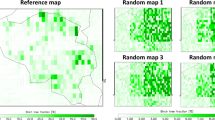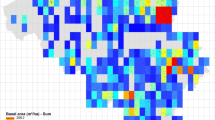Abstract
This paper considers the feasibility of numerical simulation of large-scale atmospheric transport of allergenic pollen. It is shown that at least small grains, such as birch pollen, can stay in the air for a few days, which leads to a characteristic scale for their transport of ∼103 km. The analytical consideration confirmed the applicability of existing dispersion models to the pollen transport task and provided some reference parameterizations of the key processes, including dry and wet deposition. The results were applied to the Finnish Emergency Dispersion Modelling System (SILAM), which was then used to analyze pollen transport to Finland during spring time in 2002–2004. Solutions of the inverse problems (source apportionment) showed that the main source areas, from which the birch flowering can affect Finnish territory, are the Baltic States, Russia, Germany, Poland, and Sweden—depending on the particular meteorological situation. Actual forecasting of pollen dispersion required a birch forest map of Europe and a unified European model for birch flowering, both of which were nonexistent before this study. A map was compiled from the national forest inventories of Western Europe and satellite images of broadleaf forests. The flowering model was based on the mean climatological dates for the onset of birch forests rather than conditions of any specific year. Utilization of probability forecasting somewhat alleviated the problem, but the development of a European-wide flowering model remains the main obstacle for real-time forecasting of large-scale pollen distribution.





Similar content being viewed by others
References
Adams-Groom B, Emberlin J, Corden J, Millington W, Mullins J (2002) Predicting the start of the birch pollen season at London, Derby and Cardiff, United Kingdom, using a multiple regression model, based on data from 1987 to 1997. Aerobiologia 18:117–123
Anttila P, Kulmala M, Raunemaa T (1987) Dry and wet deposition of Chernobyl aerosols in Southern Finland. J Aerosol Sci 18(6):939–942
Aylor DE (2002) Settling speed of corn (Zea mays) pollen. J Aerosol Sci 33:1601–1607
Campbell ID, McDonald K, Flannigan MD, Kringayark J (1999) Long-distance transport of pollen into the Arctic. Nature 399:29–30
CEC (1994) CORINE land cover. Technical guide. Luxembourg
Chamberlain AC (1953) Aspects of travel and deposition of aerosol and vapour clouds, A.E.R.E. Harwell, report 1261, 31pp
Corden JM, Stach A, Milligton W (2002) A comparison of Betula pollen season at two European sites; Derby, United Kingdom and Poznan, Poland (1995–1999). Aerobiologia 18:54–53
Damialis A, Gioulekas D, Lazopoulou C, Balafoutis C, Vokou D (2004) Transport of airborne pollen into the city of Thessaloniki: the effects of wind direction, speed and persistence. Int J Biometeorol 49:139–145, DOI 10.1007/s00484-004-0229-z
EMEP (2004) Co-operative Programme for monitoring and evaluation of the long-range transmissions of air pollutants in Europe, Web home page http://www.emep.int
Frøsig A, Rasmussen A (2003) Astma-Allergi Forbundet Pollen- & Sporemålinger i Danmark Sæsonen 2001 Danish Meteorological Institute Technical report 03-10, ISSN: 1399–1388 35 pp
Helbig N, Vogel B, Vogel H, Fiedler F (2004) Numerical modelling of pollen dispersion on the regional scale. Aerobiologia 20(1):3–19
Hjelmroos M (1992) Long-distance transport of Betula pollen grains and allergic symptoms. Aerobiologia 8:231–236
Horn H-G, Bonka H, Maqua M (1987) Measured particle bound activity size-distribution, deposition velocity, and activity concentration in rainwater after the Chernobyl accident. J Aerosol Sci 18:681–684
Hänninen H (1990) Modelling bud dormancy release in trees from cool and temperate regions. Acta Forestalia Fennica 213, 47pp
Høgda KA, Karlsen SR, Solheim I, Tommervik H, Ramfjord H (2002) The start dates of birch pollen seasons in Fennoscandia studied by NOAA AVHRR NDVI data. Proceeding of IGARSS. 24–28 June 2002, Toronto, Ontario, Canada. ISBN 0-7803-7536-X
IPG (2004) International Phenological Gardens: http://www.agrar.hu-berlin.de/pflanzenbau/agrarmet/ipg_2.html
Jylhä K (1991) Empirical scavenging coefficients of radioactive substances released from Chernobyl. Atmos Environ 25A(2):263–270
Keynan N, Waisel Y, Shomerilan A, Goren A, Brener S (1991) Annual variations of airborne pollen in the coastal plain of Israel. Grana 30:477–480
Köbler R, Seufert G (2001) Novel maps for tree species in Europe. Proceedings of the European Symp. on the Physico-Chemical Behaviour of Air Pollutants:”A Changing Atmosphere” Torino(It) 17–20 September 2001
Linkosalo T (2000a) Mutual regularity of spring phenology of some boreal tree species: predicting with other species and phenological models. Can J For Res 30:667–673
Linkosalo T (2000b) Analyses of the spring phenology of boreal trees and its response to climate change. Ph.D. dissertation. University of Helsinki Department of Forest Ecology Publications 22. 55pp
Luomajoki A (1999) Differences in the climatic adaptation of silver birch (Betula pendula) and downy birch (Betula pubescens) in Finland based on male flowering phenology. Acta Forestalia Fennica 263, Finnish Society of Forest Science
Małgorzata L, Miętus M, Uruska A (2002) Seasonal variations in the atmospheric Betula pollen count in Gdañsk (southern Baltic coast) in relation to meteorological parameters. Aerobiologia 18:33–43
Mücher CA (2000) (ed) Pan-European Land Cover Mapping (PELCOM) project. Development of a consistent methodology to derive land cover information on a European scale from remote sensing for environmental modeling. 299 pp
Pisarenko AI, Starkhov VV, Päivinen R, Kuusela K, Dyakun FA, Sdobnova VV (2001) Development of forest resources in the Europen part of the Russian Federation. European Forest Institute. Res Rep 11, 64pp
Porsbjerg C, Rasmussen A, Backer V (2003) Airborne pollen in Nuuk, Greenland, and the importance of meteorological parameters. Aerobiologia 19:29–37
Päivinen R, Lehikoinen M, Schuck A, Häme T, Väätäinen S, Kennedy P, Folving S (2001) Combining Earth Observation Data and Forest Statistics. EFI Research Report 14. European Forest Institute, Joint Research Centre - European Commission. EUR 19911 EN. 101 pp
Rantio-Lehtimäki A (1994) Short, medium and long range transported airborne particles in viability and antigenicity analyses. Aerobiologia 10:175–181
Rantio-Lehtimäki A, Matikainen E (2002) Pollen allergen reports help to understand preseason symptoms. Aerobiologia 18:135–140
Rötzer T, Chmielewski F-M (2001) Phenological maps of Europe. Clim Res 18:249–257
Sarvas R (1972) Investigations on the annual cycle of development of forest trees. Active period. Commun Inst For Fenn 76.3:1–110
Schaber J, Badeck FW (2003) Physiology-based phenology models for forest tree species in Germany. Int J Biometeorol 47:193–201, DOI 10.1007/s00484-003-0171-5
Schuck A, Van Brusselen J, Päivinen R, Häme T, Kennedy P, Folving S (2002) Compilation of a calibrated European forest map derived from NOAA-AVHRR data. European Forest Institute. Internal Rep. 13, 44pp. plus Annexes
Severova E, Polevova S (1996) Aeropalynological calendar for Moscow 1994. Ann Agric Environ Med 3:115–119
Siljamo P, Sofiev M, Ranta H (2004) An approach to simulation of long-range atmospheric transport of natural allergens: an example of birch pollen. In Air Pollution Modelling and its Applications XVII (in press.), also in pre-prints of 27-th Int. Technical Meeting on Air Pollution Modelling and its Applications, Banff, 23–30.10.2004, Canada, pp 395–402
Smith FB, Clark MJ (1989) The transport and deposition of radioactive debris from the Chernobyl nuclear power plant accident with special emphasis on consequences to the United Kingdom. Met. Off. Sci. Pap, N42. HMSO, London
Sofiev M, Atlaskin E (2004) An example of application of data assimilation technique and adjoint dispersion modelling to an inverse dispersion problem based on the ETEX experiment. In Air Polution Modelling and its Applications XVII (in press.), also in pre-prints of 27-th Int. Technical Meeting on Air Pollution Modelling and its Applications, Banff, 23–30.10.2004, Canada, pp. 405–412
Sofiev M, Siljamo P (2003) Forward and inverse simulations with Finnish emergency model SILAM. In: C.Borrego, S. Incecik (eds) Air pollution modelling and its applications XVI. Kluwer Acad./Plenum Publ., pp 417–425
Torseth K (2004) (ed) Transboundary particulate matter in Europe. Status report 4/2004. EMEP/CCC, EMEPMSC-W, EMEP/CIAM joint report, NILU, O-98134, Lillestrom, 2004, 163 pp
UN-ECE (1998) International Co-operative Programme on Assessment and Monitoring of Air pollution Effects on Forests. Manual on methods and criteria for harmonized sampling, assessment, monitoring and analysis of the effects of air pollution on forests
WHO (2003) Phenology and human health: allergic disorders. Copenhagen, WHO Regional Office for Europe, 55 pp
Acknowledgements
The work was done within the scope of the common POLLEN project of the Aerobiological Group of the University of Turku and the Finnish Meteorological Institute.The authors also gratefully acknowledge the support of the Emil Aaltonen foundation in the form of a personal grant for P. Siljamo. Computations partially relied upon data and methodologies kindly provided by the International Phenological Garden (IPG) project. Discussions with, and support of, Jaakko Kukkonen are greatly appreciated.
Author information
Authors and Affiliations
Corresponding author
Rights and permissions
About this article
Cite this article
Sofiev, M., Siljamo, P., Ranta, H. et al. Towards numerical forecasting of long-range air transport of birch pollen: theoretical considerations and a feasibility study. Int J Biometeorol 50, 392–402 (2006). https://doi.org/10.1007/s00484-006-0027-x
Received:
Revised:
Accepted:
Published:
Issue Date:
DOI: https://doi.org/10.1007/s00484-006-0027-x




